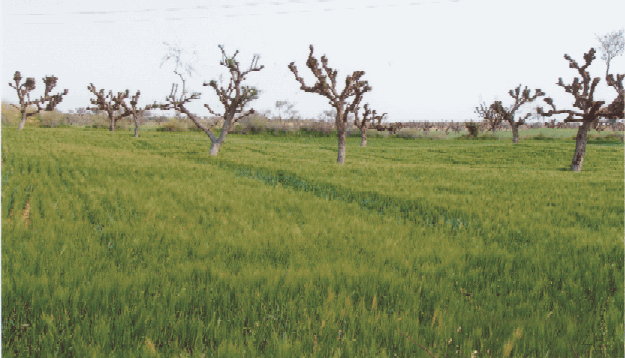In last couple of years, it was observed that dual purpose barley can be utilized as an alternative source of green forage in the arid and semi arid regions as parts of states like Rajasthan, Haryana, Punjab, M.P. and U.P due to increasing scarcity of green forage availability (Fig. 1).

The marginal farmers would prefer to grow barley varieties giving high forage yield for their live stock and food-grain for human consumption, as it is an outstanding source of proteins, vitamins and minerals.
Also in case of hills, most of the farmers are growing barley in apple orchards mainly for utilization as green forage. During the late seventies a few varieties like Azad, K141 and Ratna were recommended for single cut for green forage. The Barley Network took a new initiative during last few years to look at the possibility of utilizing barley as a dual purpose crop to meet the requirements in association with AICRP-FC, Jhansi. It was found that barley crop can be given one cut (at 50-55 days after sowing in plains and 70-75 days after sowing in hills) for green forage and the regenerated crop can be utilized for grain purposes. A new series of yield trials was initiated from 2003-04 crop season for dual-purpose barleys in plains and hills zones to identify suitable genotypes. Already released feed type varieties RD 2035 and RD 2552 have been found equally good to be used as dual purpose. Two more new varieties (RD 2715 for central zone and BHS 380 for NH zone) have been released by CVRC as dual purpose barley as forage cum grain crop (Table 1).
Table 1. Dual purpose barley varieties released in India
|
Variety |
Year |
Production Condition |
Area of Adaptation |
Developed at |
|
RD 2715 |
2008 |
Irrigated |
Central zone |
ARS, Durgapura |
|
BHS 380 |
2010 |
Rainfed |
Northern Hills |
IARI, RS, Shimla |
|
RD 2035 |
1994* |
Irrigated |
NWPZ |
ARS, Durgapura |
|
RD 2552 |
1999* |
Irrigated |
NWPZ |
ARS, Durgapura |
*These varieties were released as grain type earlier but also observed best for dual purpose in northern plains
There is immense need to continue working on this area to develop better varieties to be used as dual purpose barley. There is also a need for evaluation of the forage quality traits to improve the overall suitability as green forage. Thus barley can serve as supplementary crop for augmenting the green forage demand in the arid/ semi arid areas of northern plains under limited irrigations and in hills under rainfed conditions. It also gives satisfactory levels of grain yield from the regenerated crop, which can also be utilized as feed for cattle or human food. The economics goes in favour of dual purpose crop instead of only grain type in forage scarcity areas of northern plains. Cultivation of dual purpose barley varieties would prove boon for meeting the forage and food requirements of the farmers for sustaining their livelihood and stabilizing productivity of barley.
Authors:
A.S. KHARUB, R.P.S. VERMA, DINESH KUMAR, B. SRKAR, R. SELVAKUMAR and VISHNU KUMAR
DIRECTORATE OF WHEAT RESEARCH, KARNAL-132001
Corresponding author’s e-mail-
